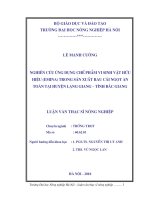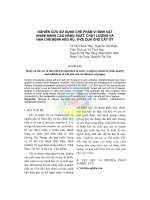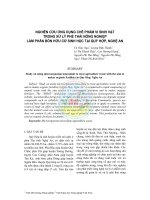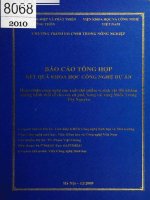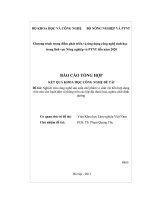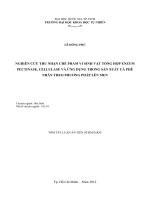NGHIÊN CỨU SẢN XUẤT CHẾ PHẨM VI SINH VẬT ĐỐI KHÁNG THÂN THIỆN VỚI MÔI TRƯỜNG TRONG PHÒNG TRỪ BỆNH BẠC LÁ LÚA ĐỐI VỚI SẢN XUẤT NÔNG NGHIỆP TẠI VIỆT NAM
Bạn đang xem bản rút gọn của tài liệu. Xem và tải ngay bản đầy đủ của tài liệu tại đây (449.23 KB, 7 trang )
<span class='text_page_counter'>(1)</span><div class='page_container' data-page=1>
<i>e-ISSN: 2615-9562 </i>
<b>RESEARCH ON PRODUCTION OF ENVIRONMENTALLY FRIENDLY </b>
<b>ANTAGONISTIC MICROORGANISMS IN THE PREVENTION OF RICE </b>
<b>BLIGHT DISEASE FOR AGRICULTURAL PRODUCTION IN VIETNAM </b>
<b>Pham Thi To Oanh </b>
<i>Vietnam Cooperative Alliance </i>
ABSTRACT
Rice leaf blight disease is one of the common diseases in rice-growing countries, including
Vietnam. Research methods were conducted such as assessing the growth of microorganisms, to
determine the antagonism of microorganisms, the ability to co-grow, the effectiveness of products,
to assess the toxicity of probiotics... The research results showed that the bacterial strains
belonging to the actinomycete groups Steptomyces sp., Bacillus spp are capable of antagonizing
<i>against Xanthomonas oryzae pv.oryzae (Xoo) causing bacterial leaf blight disease, with 4 strains </i>
of bacteria PD17, PD13.1, KND, KXT1 and 2 strains of actinomycetes XKBL2 and XKBL3;
Identified suitable conditions for growth: temperature 200<sub>C-50</sub>0<sub>C, pH 5.5-8, fermentation </sub>
environment to produce probiotics (7-day for fermented powder and 5-day for fermented liquid).
The probiotics production process was experimented in laboratory, through practical tests,
evaluation of suitability, toxicity test, calculation of economic efficiency and then confirmed to
practical effection in Moc Bac Cooperative, Duy Tien district, Ha Nam province.
<i><b>Keywords: Bacterial leaf blight disease; antagonistic microorganisms; actinomycetes; </b></i>
<i>preparations; rice blight desease </i>
<i><b>Received: 23/3/2020; Revised: 29/4/2020; Published: 29/4/2020</b></i>
<b>NGHIÊN CỨU SẢN XUẤT CHẾ PHẨM VI SINH VẬT ĐỐI KHÁNG </b>
<b>THÂN THIỆN VỚI MÔI TRƯỜNG TRONG PHÒNG TRỪ BỆNH BẠC LÁ LÚA </b>
<b>ĐỐI VỚI SẢN XUẤT NÔNG NGHIỆP TẠI VIỆT NAM </b>
<b>Phạm Thị Tố Oanh </b>
<i>Liên minh Hợp tác xã Việt Nam </i>
TÓM TẮT
Bệnh bạc lá lúa là một trong những bệnh phổ biến ở các nước trồng lúa, trong đó có Việt Nam.
Các phương pháp nghiên cứu được sử dụng là đánh giá sự sinh trưởng của vi sinh vật, xác định
tính đối kháng của vi sinh vật, khả năng đồng sinh trưởng, hiệu quả của sản phẩm, đánh giá độc
tính của chế phẩm,... Kết quả nghiên cứu cho thấy các chủng vi sinh vật thuộc nhóm xạ khuẩn
Steptomyces sp., Bacillus spp có khả năng sinh chất đối kháng với vi khuẩn Xanthomonas oryzae
<i>pv.oryzae (Xoo) gây bệnh bạc lá lúa, với 4 chủng vi khuẩn PD17, PD13.1, KND, KXT1 và 2 </i>
chủng xạ khuẩn XKBL2, XKBL3; xác định được các điều kiện phù hợp cho sinh trưởng: nhiệt độ
200<sub>C -50</sub>0<sub>C, pH 5,5-8, môi trường lên men để sản xuất chế phẩm (dạng bột lên men 7 ngày và </sub>
dạng lỏng lên men 5 ngày). Quy trình sản xuất chế phẩm được triển khai trong phịng thí nghiệm
và trong thực tiễn nhằm đánh giá được tính thích nghi, kiểm tra độc tính, tính tốn hiệu quả kinh
tế, khẳng định hiệu quả tại hợp tác xã Mộc Bắc, huyện Duy Tiên, tỉnh Hà Nam.
<i><b>Từ khóa: Bệnh bạc lá do vi khuẩn; vi sinh vật đối kháng; xạ khuẩn; chế phẩm; bệnh bạc lá lúa </b></i>
<i><b>Ngày nhận bài: 23/3/2020; Ngày hoàn thiện: 29/4/2020; Ngày đăng: 29/4/2020 </b></i>
<i>Email: </i>
</div>
<span class='text_page_counter'>(2)</span><div class='page_container' data-page=2>
<b>1. Introduction </b>
Bacterial leaf blight disease was first
discovered in Fukuoko, Kyushu, Japan in
1884. Currently, rice blight disease has
occurred in many countries, especially in Asia
(including Vietnam); reducing yield at
different levels. In some Asian and Southeast
Asian countries, rice blight disease usually
reduces yield by 10-20% but can be as high as
50% [1]. The main harms are rice leaves,
early blighting stems, quickly drying off,
ragged rice leaves, adversely affecting the
photosynthetic efficiency of dry matter
accumulation, reducing the number of ears
and seed quantity, reducing grain weight. In
Vietnam, rice leaf blight disease is detected in
many regions. The disease can arise and
develop in all rice crops (winter-spring or
summer-autumn), on many different rice
varieties. In 2019, Vietnam has 89,272
hectares of rice, of which the area infected
with leaf blight disease is 57,234 hectares, an
increase compared to previous years [2].
Many studies have focused on the use of
chemicals (Japan has allowed the use of
chloramphenicol, nickel-dimethyldithiocarbamate,
dithianon.... while Vietnam is using Sasa
20WP, 25WP, Kaisin 50, 100WP, Kamsu
2SL, 4SL, Kasumin 2SL...). Research shows
that, at present, chemical spraying is not
effective when rice fields are seriously
infected, large doses of drugs must be used;
therefore, there is a huge residue in the
environment, inhibiting and destroying many
other useful bacteria, leading to ecological
imbalance [3].
Selection of disease-resistant rice varieties is
a method being implemented. Plant resistance
is the ability of the plant to reduce parasite
growth and development after the parasite's
contact with the host is initiated. Initially, the
variety exhibited very good disease resistance
but a few years later it became infected again
- this is called a break in the resistance of a
variety that is caused by the presence of a
new bacteria strain with higher toxicity. In
1961, Nishimura studied the disease
resistance gene, in which a leaf blight disease
resistance was controlled by a dominant gene
[4]. The large and long-term scale of rice
grown with a single gene may result in the
development of pathogens again and the
resistance of the single-gene will decrease.
This study focused on the microorganisms
belonging to the Steptomyces sp., Bacillus
spp actinomycetes groups, which are
<i>antagonistic to Xoo causing bacterial leaf </i>
blight disease. Research on a trial scale and
<i>put into trial production of Xoo antimicrobial </i>
products was deployed in the field. The
bacterium was first named Bacillus oryzae by
Japanese scientists Hori and Bokura in 1911
and is now known as Xanthomonas
campestris pv.oryzae. The bacterium has a
rod-shaped cell with a round tip, 0.8 to 1 µm
in length, 0.4-0.7 µm in width, surrounded by
a mucous membrane; a Gram-negative and
non-spore-forming, round, smooth,
lime-yellow colonies. The bacterium mainly
invades the plant through scabbing wounds on
leaves through stomata, invading from
irrigation water, through the vascular system,
and leading to infection of the whole rice
plant; can penetrate through the lobe holes at
the leaf margins, the tip of the leaf are easily
damaged along the veins. The bacteria only
survive in water for less than 15 days [5].
<b>2. Research method </b>
Research of suitable microorganisms for
probiotics production: 6 strains of Xanthomonas
oryzae pv.oryzae, 4 strains of Bacillus spp. Trial
rice varieties in Moc Bac Cooperative, Duy
Tien district, Ha Nam province.
Chemicals: meat extract, yeast extract, amino
acid, NaCl, K2HPO4, KH2PO4,...
Tools: 500 ml conical flask; 250 ml, peptri
dishes, measuring cups, measuring tubes,
alcohol lamps, etc.
</div>
<span class='text_page_counter'>(3)</span><div class='page_container' data-page=3>
<i><b>2.1. Methods of assessing the growth of </b></i>
<i><b>microorganisms: </b></i>
<i>Methods for determining cell density </i>
X = a x b x 10 (CFU/ml or CFU/g) (1)
<i>a: the number of colonies appearing on the </i>
<i>Petri dish </i>
<i>b: reciprocal of dilution concentration </i>
<i>- Quantification of spores: diluted samples </i>
were treated with thermal shock at 800C for
10 minutes, then let it cool in ice water for 5
minutes. Samples were cultured on MPA
medium. Count the number of colonies were
formed on the medium after 24 hours of
incubation at 300C. The number of spores
were determined by formula 1.
<i>- Determination of bacterial biomass (method </i>
<i>of measuring optical density OD): The </i>
microorganisms cultured in liquid medium
after 24 hours are taken to determine the
optical density to assess the level of growth
among experimental samples. Samples were
compared in colors with reference samples
(no microbiological culture) by UV-vis
colorimeter at 560 nm [6].
- Determination of dry biomass of
actinomycetes formed after culture was
collected by filtration through filter paper, dried
at 1050<sub>C to constant mass. Weigh the obtained </sub>
weight and determine it by formula 2.
Mxkk= M1- M0 (2)
<i>Of which: Mxkk: The dry biomass of </i>
<i>actinomycetes </i>
<i>M1: Mass of actinomycetes and filter </i>
<i>paper after drying </i>
<i>M0: Volume of filter paper </i>
<i><b>2.2. Methods of determining the antagonism </b></i>
<i><b>of microorganisms: The method of agar bars, </b></i>
<b>the method of agar wells </b>
<i><b>2.3. Method for assessing co-growth ability: </b></i>
<i><b>Studying factors affecting the growth of </b></i>
<i><b>selected microorganisms: temperature (15</b></i>0<sub>C, </sub>
200<sub>C, 25</sub>0<sub>C, 30</sub>0<sub>C, 35</sub>0<sub>C, 40</sub>0<sub>C, 45</sub>0<sub>C; pH ( 4.0; </sub>
4.5; 5.0; 5.5; 6.0; 7.0; 8.0; 8.5; 9.0; 9.5),
source and concentration of carbon, nitrogen,
<i><b>and mineral. </b></i>
<i><b>2.4. Evaluation of the effectiveness of the </b></i>
<i><b>product </b></i>
Evaluation of the antagonistic ability of
probiotics in experiments evaluating the
effectiveness of preventing leaf blight disease
<i>caused by Xoo bacteria through experiments </i>
with different concentrations of probiotics
<i>and suspension of Xoo. </i>
Assessing the ability to prevent leaf blight
disease in rice: arranging experiments at the
jar scale in a laboratory; arranging testing of
seed treatment preparations, combined with
soil treatment; experimental arrangement of
probiotics at Moc Bac Cooperative, Duy Tien
district, Ha Nam province.
<i><b>2.5. Assessment of toxicity of the product: </b></i>
The mice were given oral preparations that
differed from their body weight. Track and
calculate the number of dead mice in each
batch and calculate the LD50<i><b> value </b></i>
The study of semi-chronic toxicity was
conducted, monitoring the ability of food intake,
movement ability compared to the control group
with some hematological indicators, liver and
kidney function enzymes [7].
<b>3. Results and discussion </b>
Selecting 21 strains of bacteria resistant to
<i>Xoo bacteria, Bacillus strains were activated </i>
in MPB and MPA environments, tested
resistance by agar bars method. The
antibacterial ring was measured after 24 hours
of incubation at 300<sub>C. Out of 17 strains that </sub>
</div>
<span class='text_page_counter'>(4)</span><div class='page_container' data-page=4>
<i><b>Table 1. Antibacterial rings of selected strains after 24 hours </b></i>
<b>No. </b> <b>Strain </b> <b>Diameter of resistance ring with single strain Xoo (mm) </b>
<b>ST1 </b> <b>ST2 </b> <b>ST3 </b> <b>ST4 </b> <b>ST5 </b> <b>ST6 </b>
1 PD17 12 15 21 32 22 20
2 KXT1 28 23 15 43 22 13
3 KND 24 16 19 33 24 22
4 PD13.1 32 20 27 35 30 20
<i>(Source: Center for Science, Technology and Environment, Vietnam Cooperative Alliance, 2019) </i>
Selection of qualified strains, continue culturing after 48 hours, temperature 300<sub>, shake 150 rpm; </sub>
<i>centrifuged fermentation; collect the supernatant fluid and test the resistance to Xoo bacteria by </i>
the method of agar wells, shown in the figures.... Based on the size of the antibacterial ring, 4
strains of bacteria PD17, PD13.1, KXT1, KND were selected in figure 1.
<i><b>Figure 1. Xoo antibacterial ring of selected bacterial strains (Experiment at the Center for Science, </b></i>
<i>Technology and Environment, Vietnam Cooperative Alliance, 2019) </i>
<i>To select the actinomycetes that are resistant to Xoo, actinomycetes are activated on agar plates </i>
containing Gause 2 medium within 5 days, then check the resistance by agar bars method. As a
<i>result, only 2 strains XKBL2 and XKBL3 have antagonistic substances against Xoo bacteria and </i>
<i>are selected for research on producing Xoo antimicrobial preparations, shown in table 2. </i>
<i><b>Table 2. Xoo's resistance to bacterial strains </b></i>
<b>No. Strain </b> <b>Diameter of resistance ring with single strain Xoo (mm) </b>
<b>ST1 </b> <b>ST2 </b> <b>ST3 </b> <b>ST4 </b> <b>ST5 </b> <b>ST6 </b>
1 XKBL2 12 13 16 10 15 14
2 XKBL3 15 16 15 11 13 14
<i>(Source: Center for Science, Technology and Environment, Vietnam Union of Cooperatives, 2019) </i>
Studying factors affecting growth and resistance of selected microorganisms. The appropriate
<i>temperature and antimicrobial agent of Xoo are selected at 22-55</i>0<i><sub>C. Xoo is a gram-negative </sub></i>
bacterium with an appropriate growth temperature of 26-300<sub>C. Two selected strains of </sub>
</div>
<span class='text_page_counter'>(5)</span><div class='page_container' data-page=5>
grow and produce the strongest antibacterial substance. Selected strains of microorganisms and
actinomycetes are able to adapt to a wide pH range from 5.0-8.5, thrive at around 6-8, have good
salinity tolerance at concentrations from 0.5 -5%.
Research the conditions to produce probiotics with mutual antagonism, nutrient source, nitrogen
concentration, mineral source..., select appropriate conditions. Fermentation environment for
<i>production of Xoo antibacterial preparations containing ingredients: molasses 25g/l, soybean </i>
meal 25 g/l, mineral NaCl 3 g/l, KH2PO4 1.5g/l, K2PHO41.5 g/l, rice bran 20 g/kg, soybean meal
25 g/kg, mineral KH2PO4 1.5g/l, K2PHO41.5 g/l, K2PHO4 1.5 g/kg, carrier 1 kg.
<i>Xoo-resistant microorganism preparations are produced in two forms: liquid (5 days) and powder </i>
(7 days). Liquid form is used for seed treatment or soil treatment. Powder is used for soil
<i>treatment for convenience during use and transportation. The process of producing Xoo-resistant </i>
microorganism preparations is shown in Figure 2.
<i><b>Figure 2. Diagram of production process of Xoo-resistant microorganisms </b></i>
</div>
<span class='text_page_counter'>(6)</span><div class='page_container' data-page=6>
ability,... Results show that the product does not exhibit acute toxicity at the studied dose levels,
even up to a maximum of 25g/kg. Therefore, the LD50 value cannot be determined.
Liquid products are packaged in 1 liter and 5 liter plastic cans. Powdered products are packed in
1 kg plastic bags. The product is tested for quality through the evaluation that there is no useful
microorganism in the product can cause diseases to animals such as E.coli or Salmonella. The
<i>quality control results of Xoo-resistant microorganisms are shown in Table 3. </i>
<i><b>Table 3. Analysis results of the quality of Xoo-resistant microorganisms at agricultural cooperative </b></i>
<b>No. </b> <b>Analytical criteria </b> <b>Unit </b> <b>Methods of analysis </b> <b>Analysis results </b>
C1 C2
1 Actinomycete CFU/g TCVN 4884:2001 2.0 x 108 <sub>1.1 x 10</sub>8
2 Bacillus.sp bacteria CFU/g TCVN 4884:2001 4.7 x 108 <sub>2.8 x 10</sub>8
3 Total Coliform CFU/g TCVN 6187-1:2009 KPHT KPHT
4 Total E.coli CFU/g TCVN 6187-1:2009 KPHT KPHT
5 Total Salmonella CFU/g TCVN 4884:2001 KPHT KPHT
<i>(Source: Center for Science, Technology and Environment, Vietnam Cooperative Alliance, 2019) </i>
<i>KPHT: Not detected in sample; M1, M2: Sample preparations </i>
Experimental preparations and economic efficiency calculations in Moc Bac Cooperative, Duy
Tien district, Ha Nam province are shown in Table 4.
<i><b>Table 4. Calculation of economic efficiency of the model (calculated for 1 hectares) </b></i>
<b>No. Production cost </b> <b>Quantity </b> <b>Unit price </b> <b>Amount (x1,000 VND) </b>
<b>Experiment </b> <b>Control </b>
<b>I </b> <b>Production cost </b> <b>20,360 </b> <b>19,067 </b>
1 Variety (1.3 kg/“sao”)* 36kg 31 1,116 1,116
2 Fertilizer 4,895 4,895
Nitrogen fertilizer (2
kg/“sao”)
55 kg 5 275 275
Viet-Japan NPK (15
kg/“sao”)
420 kg 11 4,620 4,620
3 Plant protection (drugs,
spraying)
5,556 5,556
4 Microbiological treatment 1,300 0
Microbial preparations 200 kg 50 1,000 0
Labor cost for spraying
microbial preparations
300 0
5 Labor cost 7,500 7,500
Land preparation, grass
removing cost (100,000
VND/“sao”)
2,778 2,778
Preparation of seeds
(soaking rice seeds,
sowing seeds)
2,778 2,778
Machine harvesting
(70,000 VND/“sao”)
1,994 1,994
<b>II </b> <b>Revenue </b> <b>5,560 </b> <b>6.5 </b> <b>36,140 </b> <b>33.02 </b>
<b>III </b> <b>Profit </b> <b>15,773 </b> <b>13,953 </b>
<b>IV </b> <b>Economic </b> <b>efficiency </b>
<b>(compared to tradition way) </b>
<b>11.54% </b>
<i>* 1 “sao” = 365 m2 </i>
</div>
<span class='text_page_counter'>(7)</span><div class='page_container' data-page=7>
<b>4. Conclusions </b>
The research has selected strains of
<i>microorganisms resistant to Xoo causing leaf </i>
blight disease, including 4 strains of bacteria
PD17, PD13.1, KND, and KXT1; with a wide
growth temperature of 220<sub>C -55</sub>0<sub>C, pH 5.5-8; </sub>
salinity tolerance 0.5-5%. The bacteria and 2
strains of XKBL2 and XKBL3 grow best at
20-350<sub>C. </sub>
The research has also identified nutrition
ingredients to serve as the production
environment; formulated a process of
producing preparations based on the
biological properties of selected
microorganisms. Preparations are produced in
liquid and powder forms. The research has
assessed the dynamics of fermentation,
thereby determining the necessary
fermentation time for production: 7-day for
powder, 5-day for liquid form. Bioproducts
are tested with results of non-toxic and
semi-chronic toxicity, do not affect the ability of
seed germination in practice and have good
disease prevention effect when used for seed
treatment before sowing and soil treatment
before transplanting rice.
When using this bioproduct for soil treatment,
the microorganisms have a better ability to
adapt to the environment. The density of
Bacillus bacteria and actinomycetes is
higher than the experimental cells without
using the bioproduct. The bioproduct
application model helped increase 11.54%
of rice yield in Moc Bac Cooperative, Duy
Tien district, Ha Nam province.
REFERENCES
[1]. K. Gu, J. S. Sangha, Y. Li, and Z. C. Yin,
“Highsolutiongenetic mapping of bacterial
<i>blightresistance gene Xa-10,” Theor. Appl. </i>
<i>Genet., vol.116, pp. 155-163, 2008. </i>
<i>[2]. Plant Protection Department, Announcement </i>
<i>of pest situation 7 days from 23 to 29 </i>
<i>September 2016, Plant Protection Department </i>
- Ministry of Agriculture and Rural
Development, 2016.
[3]. M. Leila, L. R. M. Rosa, and M. S. M. Ana,
“Antagonism of Bacillus spp. Against
Xanthomonas campestris pv.campestris,”
<i>Brazilial archives of Biology and Technology, </i>
vol. 48(1), pp. 23-29, 2005.
[4]. A. S. Iyer, and S. R. McCouch, “The rice
bacterial blight resistance gen xa – 5 encodes a
<i>novel form of disease resistance,” Mol. Plant </i>
<i>Microbe Inter., vol.17, pp. 1348-1354, 2004. </i>
[5]. D. B. Ngo, T. M. T. Le, T. T. H. Trinh, K. T.
Pham, M. H. Pham, T. L. Nguyen, T. H. N.
Le and V. T. Dang, “35 research and
development of biological insecticide Bacillus
<i>thuringiensis in Vietnam,” 35th Scientific </i>
Conference of Vietnam Academy of Science
and Technology, 2012, pp. 286-297.
[6]. T. P. H. Pham, V. H. Duong, T. V. Nguyen,
H. A. Nguyen, T. A. D. Nguyen, T. K. Q.
Nguyen, H. M. Q. Nguyen, and V. T. Nguyen,
“Research on stimulating antibacterial
actinomycetes to kill Xanthomonas oryzae
pv.oryzae causing rice leaf blight disease in
Vietnam,” The 4th National Scientific
Conference on Ecology and Microbiological
Resources, 2015, pp. 1127-1133.
</div>
<!--links-->
